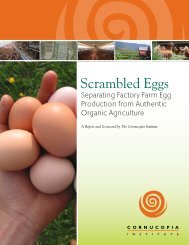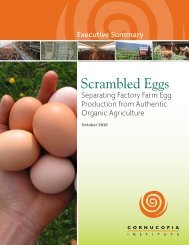“Behind the Bean” (pdf) - Cornucopia Institute
“Behind the Bean” (pdf) - Cornucopia Institute
“Behind the Bean” (pdf) - Cornucopia Institute
Create successful ePaper yourself
Turn your PDF publications into a flip-book with our unique Google optimized e-Paper software.
Hexane Residues in Food<br />
Th e FDA d o e s n o t set a m a x i m u m residue level in soy foods for hexane, and does not require that food manufacturers test<br />
for hexane residues. Very little research has been conducted concerning <strong>the</strong> potential effects of consuming hexane residues<br />
in edible oils and o<strong>the</strong>r processed foods that contain soy protein, such as infant formula, energy bars, protein powders, and<br />
meat analogs. Food processors that use hexane tend to assume that nearly all hexane residues evaporate before reaching <strong>the</strong><br />
consumer, but this may not be <strong>the</strong> case.<br />
Studies on hexane-extracted oils show that not all hexane evaporates before consumption—residues can appear in foods.<br />
According to EPA reports, 97 small quantities of solvent (up to 0.2 percent by volume of oil) can be present in oil after extraction,<br />
even after solvent recovery by film evaporators and a distillation stripper. A Swiss team of scientists tested various oils<br />
and found hexane residues in some of <strong>the</strong> tested oils. 98<br />
Moreover, residue testing has tended to focus on <strong>the</strong> oil, but <strong>the</strong> protein and fiber that are left after extraction have also<br />
come in contact with hexane. To test for <strong>the</strong> possibility of hexane residues on <strong>the</strong>se o<strong>the</strong>r soy components and products, The<br />
<strong>Cornucopia</strong> <strong>Institute</strong> sent a sample of hexane-extracted soy oil, soy meal, and soy grits to an independent analytical laboratory<br />
(registered with <strong>the</strong> FDA and USDA). While <strong>the</strong>re was less than 10 ppm hexane residue in <strong>the</strong> oil, both <strong>the</strong> soy meal<br />
and soy grits contained higher levels of hexane residues. The soy meal contained 21 ppm hexane and <strong>the</strong> grits contained 14<br />
ppm. These tests raise important questions regarding <strong>the</strong> presence of hexane residues in everyday foods.<br />
The effects of consuming foods that contain hexane-extracted ingredients are not known. As with most of <strong>the</strong> approximately<br />
70,000 chemicals that are registered with <strong>the</strong> EPA for commercial use, hexane has been tested for its effects on workers<br />
but has not been tested for its effects on consumers as part of <strong>the</strong> human diet. And, it appears that no studies looking for<br />
syn<strong>the</strong>tic breakdown constituents of hexane in food are available. O<strong>the</strong>r hydrocarbon solvents, such as benzene, can interfere<br />
with human development, causing a spectrum of disorders including structural birth defects, hyperactivity, attention<br />
deficits, reduced IQ, and learning and memory deficiencies. 99 Hexane is considered to be less toxic than benzene, but few<br />
studies are available on <strong>the</strong> long-term effects of consuming hexane-extracted foods.<br />
The <strong>Cornucopia</strong> <strong>Institute</strong> is petitioning <strong>the</strong> FDA to examine <strong>the</strong> effects of hexane in foods. First, <strong>Cornucopia</strong> is asking<br />
<strong>the</strong> FDA to test commonly consumed soy derivatives, such as soy protein isolate, for hexane residues. Second, if residues<br />
are indeed found to be common in foods, <strong>the</strong> FDA should provide information to consumers regarding <strong>the</strong> effects of <strong>the</strong>se<br />
chemical residues on consumers, including infants and children.<br />
We believe that this research is especially important given <strong>the</strong> fact that most soy-based infant formulas contain ingredients<br />
that have been hexane extracted. In fact, nearly every major ingredient in conventional soy-based infant formula is hexane<br />
extracted. Infants consume much greater quantities of food compared to <strong>the</strong>ir body weight than adults, and formula-fed<br />
infants consume <strong>the</strong> same foods day after day, for many months. If hexane residues are present in conventional soy-based<br />
infant formula, <strong>the</strong>ir effects on infants should be investigated.<br />
Hexane and “Natural” Soy Foods: Vegetarian Burgers and<br />
Meat Analogs with Soy Protein<br />
Un l e s s a s o y -b a s e d v e g e ta r i a n b u r g e r or meat analog product is organic, with <strong>the</strong> green USDA Organic seal on <strong>the</strong> package,<br />
it almost certainly contains hexane-extracted soy protein, such as soy protein isolate or soy protein concentrate. Texturized<br />
vegetable protein is also a common ingredient in meat analogs and is usually a soy isolate or concentrate that has been<br />
fur<strong>the</strong>r processed with high heat and pressure to resemble <strong>the</strong> texture of real meat.<br />
To make conventional soy protein ingredients, food manufacturers start <strong>the</strong> process by literally immersing soybeans in a<br />
hexane “bath.” A common additional technique to fur<strong>the</strong>r separate out <strong>the</strong> protein is bathing soy flakes in aqueous alcohols<br />
such as methanol, ethanol, or isopropyl alcohol. Processors also commonly use acid and alkaline solutions to adjust <strong>the</strong> pH,<br />
and use high heat and high pressure to texturize <strong>the</strong> soy protein.<br />
Organic soy protein has been available for years, but food manufacturers have been hesitant to use it because of its lower<br />
36 Behind <strong>the</strong> bean: The Heroes and Charlatans of <strong>the</strong> Natural and Organic Soy Foods Industry.





